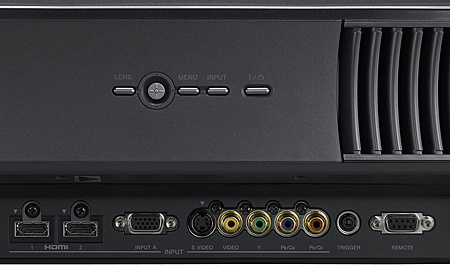Sony VPL-VW60 SXRD Video Projector

Now, barely a year after it hit the market, the VPL-VW50 has been replaced by the VPL-VW60. Priced at $5000, the same as its predecessor, the new model employs refined SXRD imaging chips that are said to provide twice the native contrast ratio of the Pearl.
But the most immediately obvious change in the VPL-VW60 is visible the minute you set eyes on it. Whereas the Pearl was a crisp white, the new model is decked out in sultry shades of metallic black and dark gray, making its nickname inevitable: the Black Pearl. But there is no pirate's curse here, just solid performance.
Features
The Black Pearl's feature set and adjustments are largely carried over from the Pearl, including the dynamic iris that Sony introduced a few years ago in its less-expensive LCD projectors. The iris opens up on bright scenes and closes down on darker ones, thus producing an enhanced dynamic contrast ratio.
Shane Buettner discusses Sony's latest implementation of this idea, called Advanced Iris 2, in his review of the Pearl. Since it operates essentially the same way in the Black Pearl, I won't plow over the details here. If you are unfamiliar with this feature, I recommend that you check out his report to learn more.
But a dynamic iris is not a free lunch. Occasionally—though not often—you can see it working. One artifact is brightness compression. A dynamic iris changes its aperture based on the average picture level. If the projector determines that the iris should close down to deepen the blacks on dark scenes with a few small, bright highlights, these bright details are dimmed as well. Star fields are perhaps the most obvious example of this.
Nevertheless, the Black Pearl's Advanced Iris 2 worked very well for me on most material, and I consider these occasional artifacts a fair tradeoff for improved blacks. Not everyone agrees, however. If you're in this group, the Black Pearl also lets you set the iris manually to one of many fixed positions. Even in this manual mode, the projector's native black level is respectably low.

There are a few new features on the Black Pearl. One of them is an additional aspect ratio: Anamorphic Zoom. This setting pre-stretches 2.35:1program material for use with an outboard, optional anamorphic lens and a 2.35:1 screen. I didn't have the opportunity to test this. (Anamorphic lenses are available from a number of suppliers, but not Sony. They aren't cheap; good ones can cost as much as the projector.)
Even more interesting is a feature called Panel Alignment. An SXRD projector uses three imaging chips, one each for red, green, and blue. This eliminates the need for the color wheel used in all single-chip DLP projectors. But the panels in a 3-chip projector must be precisely aligned or convergence errors can result. The Black Pearl's Panel Alignment feature can move the red and blue images horizontally and vertically in fractions of a pixel. The improvement provided by this adjustment was not perfect over the entire screen, but the center convergence was excellent, and the errors elsewhere were no more than a pixel—and usually less.
As with the Pearl, the lens adjustments on the Black Pearl—zoom, focus, and vertical shift—are all motorized. Also like earlier Sony projectors, the Black Pearl is as silent as any projector you'll find, even in the High lamp setting. It also accepts 1080p/24 signals from a Blu-ray or HD DVD player and converts them to 96Hz for display using an interpolation algorithm.




























































